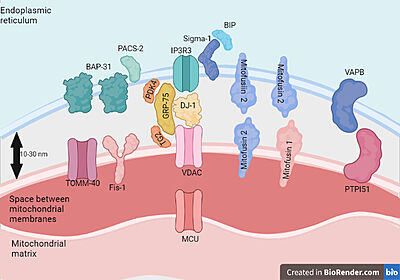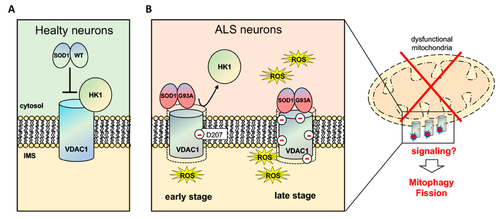User:Maria Carolina Boer Copstein/Sandbox 1
From Proteopedia
(Difference between revisions)
| Line 31: | Line 31: | ||
== Neurodegenerative disease == | == Neurodegenerative disease == | ||
[[Image:ALS dysfunctions.png|500px|right|thumb| Your Caption Text]] | [[Image:ALS dysfunctions.png|500px|right|thumb| Your Caption Text]] | ||
| - | + | Several studies have already observed the participation of VDAC1 in mitochondrial dysfunctions observed in several neurodegenerative diseases and constitutes a point of accumulation of protein aggregates with Tau,β amyloid,SOD1 that are present in these pathologies. Due to the involvement of VDAC1 in metabolism and processes of apoptosis this protein becomes a possible therapeutic target of these diseases.The Cu/Zn superoxide dismutase (SOD1) associates with about 20% of familial ALS (fALS) cases and over 180 mutant forms of enzymatically active or inactive SOD1 have been characterized in humans (http://alsod.iop.kcl.ac.uk). In affected tissues, toxic effects of SOD1 mutants are related to the formation of misfolded SOD1 aggregates upon the mitochondrial surface, leading to morphological degeneration and malfunctioning of the organelle.In the spinal cord from ALS patients, voltage dependent anion selective channel isoform 1 (VDAC1) represents the docking site on the outer mitochondrial membrane for ALS-linked SOD1 mutants.In ALS, the VDAC1-SOD1 mutant interaction strongly affects the functional properties of VDAC1 | |
| + | channel suggesting a role in the impairment of the bioenergetics metabolism and oxidative stress of | ||
| + | ALS motor neurons.It is also known that low levels of hexokinase I (HK1) in the spinal cord make motor neurons more susceptible to ALS in comparison to other tissues. In particular, this reduction of HK1 levels increases the availability of VDAC1 to interact with mutant SOD1, thereby facilitating mitochondrial dysfunction and cell death.he abnormal accumulation of misfolded proteins and dysfunctional mitochondria is a distinctive feature of ALS and many neurodegenerative diseases.VDAC1 is the receptor of HK1 and of many other enzymes and metabolites (not shown), but not of SOD1WT Conversely, in ALS, SOD1G93A is | ||
| + | able to bind deamidated VDAC1 impairing thus the binding of HK1 and likely of others physiological interactors A is able to bind deamidated VDAC1 impairing thus the binding of HK1 and likely of others physiological interactors. We propose that deamidation of VDAC1 residues parallels oxidative stress levels, leading to the enhancement of SOD1 mutant binding to VDAC1. As a consequence, VDAC1 channel conductance and metabolic exchanges through VDAC1 are gradually affected, promoting a growing mitochondrial dysfunction. The oxidative damage that accumulates with disease | ||
| + | progression produces therefore dysfunctional mitochondria tagged with deamidated VDAC1 that could be selected and forwarded to mitophagy or fission processes. | ||
Revision as of 08:03, 13 December 2021
| |||||||||||
References
Magri Andrea ,Messina Angela, “Interactions of VDAC with Proteins Involved in Neurodegenerative Aggregation: An Opportunity for Advancement on Therapeutic Molecules”, Current Medicinal Chemistry 2017; 24(40) . https://doi.org/10.2174/0929867324666170601073920
Hosaka T, Okazaki M, Kimura-Someya T, et al. Crystal structural characterization reveals novel oligomeric interactions of human voltage-dependent anion channel 1. Protein Sci. 2017;26(9):1749-1758. doi:10.1002/pro.3211


